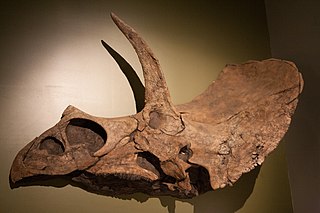 W
WAlbertosaurus is a genus of tyrannosaurid theropod dinosaurs that lived in western North America during the Late Cretaceous Period, about 70 million years ago. The type species, A. sarcophagus, was apparently restricted in range to the modern-day Canadian province of Alberta, after which the genus is named, although an indeterminate species has been discovered in the Corral de Enmedio and Packard Formations in Mexico. Scientists disagree on the content of the genus, with some recognizing Gorgosaurus libratus as a second species.
 W
WAnchiceratops is an extinct genus of chasmosaurine ceratopsid dinosaur that lived approximately 72 to 71 million years ago during the latter part of the Cretaceous Period in what is now Alberta, Canada. Anchiceratops was a medium-sized, heavily built, ground-dwelling, quadrupedal herbivore that could grow up to an estimated 5 m (16.4 ft) long. Its skull featured two long brow horns and a short horn on the nose. The skull frill was elongated and rectangular, its edges adorned by coarse triangular projections. About a dozen skulls of the genus have been found.
 W
WAtrociraptor is a genus of dromaeosaurid theropod dinosaur from the Late Cretaceous of Alberta, Canada.
 W
WEdmontonia is a genus of armoured dinosaur from the Late Cretaceous Period. It is part of the Nodosauridae, a family within Ankylosauria. It is named after the Edmonton Formation, the unit of rock it was found in.
 W
WEdmontosaurus regalis is a species of comb-crested hadrosaurid (duck-billed) dinosaur. Fossils of E. regalis have been found in rocks of western North America that date from the late Campanian stage of the Cretaceous Period 73 million years ago.
 W
WEotriceratops is a genus of herbivorous ceratopsian dinosaurs which lived in the area of North America during the late Cretaceous period. The only named species is Eotriceratops xerinsularis.
 W
WEpichirostenotes is a genus of oviraptorosaurian dinosaur from the late Cretaceous. Epichirostenotes is known from an incomplete skeleton found in 1923 at the Horseshoe Canyon Formation, in strata dated to about 72 million years ago. It was first named by Robert M. Sullivan, Steven E. Jasinski and Mark P.A. van Tomme in 2011 and the type species is Epichirostenotes curriei. Its holotype, ROM 43250, had been assigned to Chirostenotes pergracilis by Hans-Dieter Sues in 1997.
 W
WOrnithomimus is a genus of ornithomimid dinosaurs from the Late Cretaceous Period of what is now North America. Ornithomimus was a swift bipedal theropod which fossil evidence indicates was covered in feathers, equipped with a small toothless beak that may indicate an omnivorous diet. It is usually classified into two species: the type species, Ornithomimus velox, and a referred species, Ornithomimus edmontonicus. O. velox was named in 1890 by Othniel Charles Marsh on the basis of a foot and partial hand from the late Maastrichtian-age Denver Formation of Colorado, United States. Another seventeen species have been named since, though most of them have subsequently been assigned to new genera or shown to be not directly related to Ornithomimus velox. The best material of species still considered part of the genus has been found in Alberta, Canada, representing the species O. edmontonicus, known from several skeletons from the early Maastrichtian Horseshoe Canyon Formation. Additional species and specimens from other formations are sometimes classified as Ornithomimus, such as Ornithomimus samueli from the earlier, Campanian-age Dinosaur Park Formation of Alberta.
 W
WPachyrhinosaurus is an extinct genus of centrosaurine ceratopsid dinosaur from the Late Cretaceous period of North America. The first examples were discovered by Charles M. Sternberg in Alberta, Canada, in 1946, and named in 1950. Over a dozen partial skulls and a large assortment of other fossils from various species have been found in Alberta and Alaska. A great number were not available for study until the 1980s, resulting in a relatively recent increase of interest in Pachyrhinosaurus.
 W
WSphaerotholus is a genus of pachycephalosaurid dinosaur from the Upper Cretaceous of the western United States and Canada. To date, three species have been described: the type species, S. goodwini, from the Den-na-zin Member of the Kirtland Formation of San Juan County, New Mexico, USA; S. buchholtzae, from the Hell Creek Formation of western Carter County, Montana, USA and the Frenchman Formation of Saskatchewan, Canada; and S. edmontonense, from the Horseshoe Canyon Formation of Alberta, Canada.
 W
WStruthiomimus is a genus of ornithomimid dinosaurs from the late Cretaceous of North America. Ornithomimids were long-legged, bipedal, ostrich-like dinosaurs with toothless beaks. The type species, Struthiomimus altus, is one of the more common small dinosaurs found in Dinosaur Provincial Park; its abundance suggests that these animals were herbivores or omnivores rather than pure carnivores.